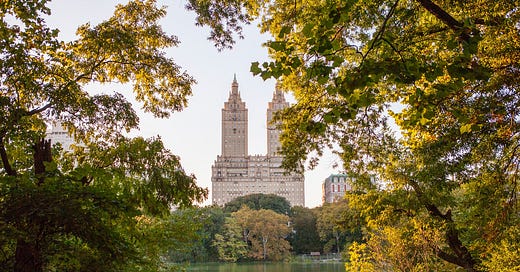Iconic Central Park Walking Tour
Explore New York's backyard, with a few stops for gluten-free treats
A few weeks ago, I published “An Art Lover’s Walking Tour of New York City” and it received a tremendous response. Since the weather is — oddly — even better now than it was then, I wanted to offer another walking tour for everyone spending time in Manhattan over Thanksgiving or for the holidays in December. This time, we explore Central Park, which is a joy to walk through at any time of the year.
Central Park is often referred to as New York’s backyard, because it’s where people walk, congregate, picnic, play frisbee, and commune with nature, among other pastimes. It’s also credited with keeping the city sane, but that seems like a stretch. Designed by Frederick Law Olmstead and Calvert Vaux in the 1850s, Central Park is 2.5 miles long (extending from 59th Street to 110th Street) and a half-mile wide (from Fifth Avenue to Central Park West). Inside those borders is a world far away from the rest of the island of Manhattan.
This walking tour should take two hours — but it will be significantly longer if you want to explore the Metropolitan Museum of Art or if you decide to go rowing on Central Park Lake. You’ll need comfortable walking shoes — exploring the park can involve dodging cyclists, joggers, and baby strollers. You can take this tour any day of the week, but avoid Wednesdays if you want to see the Met (it’s closed that day) and keep in mind that weekends are extra-busy. There are walking directions in the text below, but click here for the Google Map I created. Using it will make it easier to follow the tour, and to spot other attractions you might want to make a detour for.
Are you ready? Let’s get going!
Keep reading with a 7-day free trial
Subscribe to Gluten-Free Guidebook to keep reading this post and get 7 days of free access to the full post archives.




